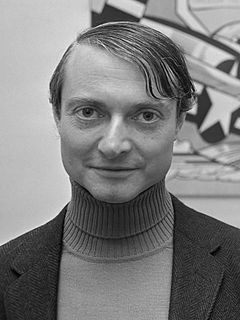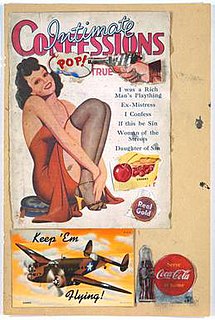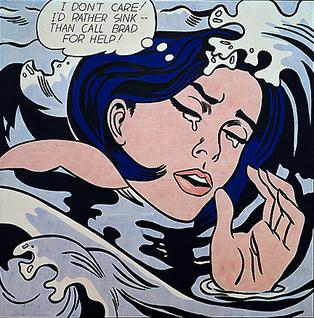
Roy Fox Lichtenstein was an American pop artist. During the 1960s, along with Andy Warhol, Jasper Johns, and James Rosenquist among others, he became a leading figure in the new art movement. His work defined the premise of pop art through parody. Inspired by the comic strip, Lichtenstein produced precise compositions that documented while they parodied, often in a tongue-in-cheek manner. His work was influenced by popular advertising and the comic book style. His artwork was considered to be "disruptive". He described pop art as "not 'American' painting but actually industrial painting". His paintings were exhibited at the Leo Castelli Gallery in New York City.

Henri Émile Benoît Matisse was a French visual artist, known for both his use of colour and his fluid and original draughtsmanship. He was a draughtsman, printmaker, and sculptor, but is known primarily as a painter. Matisse is commonly regarded, along with Pablo Picasso, as one of the artists who best helped to define the revolutionary developments in the visual arts throughout the opening decades of the twentieth century, responsible for significant developments in painting and sculpture.

Pop art is an art movement that emerged in the United Kingdom and the United States during the mid- to late-1950s. The movement presented a challenge to traditions of fine art by including imagery from popular and mass culture, such as advertising, comic books and mundane mass-produced objects. One of its aims is to use images of popular culture in art, emphasizing the banal or kitschy elements of any culture, most often through the use of irony. It is also associated with the artists' use of mechanical means of reproduction or rendering techniques. In pop art, material is sometimes visually removed from its known context, isolated, or combined with unrelated material.

Visual art of the United States or American art is visual art made in the United States or by U.S. artists. Before colonization there were many flourishing traditions of Native American art, and where the Spanish colonized Spanish Colonial architecture and the accompanying styles in other media were quickly in place. Early colonial art on the East Coast initially relied on artists from Europe, with John White the earliest example. In the late 18th and early 19th centuries, artists primarily painted portraits, and some landscapes in a style based mainly on English painting. Furniture-makers imitating English styles and similar craftsmen were also established in the major cities, but in the English colonies, locally made pottery remained resolutely utilitarian until the 19th century, with fancy products imported.
Events from the year 1989 in art.

The Phillips Collection is an art museum founded by Duncan Phillips and Marjorie Acker Phillips in 1921 as the Phillips Memorial Gallery located in the Dupont Circle neighborhood of Washington, D.C. Phillips was the grandson of James H. Laughlin, a banker and co-founder of the Jones and Laughlin Steel Company.
Calvin Tomkins is an author and art critic for The New Yorker magazine.
Sylvia Snowden is an African American abstract painter who works with acrylics, oil pastels, and mixed media to create textured works that convey the "feel of paint". Many museums have hosted her art in exhibits, while several have added her works to their permanent collections.

Herbert Vogel and Dorothy Vogel, once described as "proletarian art collectors," worked as civil servants in New York City for more than a half-century while amassing what has been called one of the most important post-1960s art collections in the United States, mostly of minimalist and conceptual art. Herbert Vogel died on July 22, 2012, in a Manhattan nursing home.

20th-century Western painting begins with the heritage of late-19th-century painters Vincent van Gogh, Paul Cézanne, Paul Gauguin, Georges Seurat, Henri de Toulouse-Lautrec, and others who were essential for the development of modern art. At the beginning of the 20th century, Henri Matisse and several other young artists including the pre-cubist Georges Braque, André Derain, Raoul Dufy and Maurice de Vlaminck, revolutionized the Paris art world with "wild", multi-colored, expressive landscapes and figure paintings that the critics called Fauvism. Matisse's second version of The Dance signified a key point in his career and in the development of modern painting. It reflected Matisse's incipient fascination with primitive art: the intense warm color of the figures against the cool blue-green background and the rhythmical succession of the dancing nudes convey the feelings of emotional liberation and hedonism.

Drowning Girl is a 1963 American painting in oil and synthetic polymer paint on canvas by Roy Lichtenstein, based on original art by Tony Abruzzo. The painting is considered among Lichtenstein's most significant works, perhaps on a par with his acclaimed 1963 diptych Whaam!. One of the most representative paintings of the pop art movement, Drowning Girl was acquired by the Museum of Modern Art in 1971.

Artist's Studio—Look Mickey is a 1973 painting by Roy Lichtenstein. It is one of five large-scale studio interior paintings in a series. The series is either referred to as the Artist's Studio series or more colloquially as the Studios and sometimes is described as excluding the other 1973 painting, reducing the series to four.
Dorothy M. Kosinski is an American scholar of nineteenth and twentieth-century art, curator and the director of The Phillips Collection, an art museum in Washington, D. C.

Ten Dollar Bill is a 1956 proto-pop art lithographic drawing by Roy Lichtenstein. Considered to be a combination of Americana art and cubism, the work is referred to as the beginning of Lichtenstein's work on pop art. Twenty-five editions of the lithograph were made by Lichtenstein, which were exhibited at several galleries. The piece is based on the design for the ten-dollar bill and has influenced several of Lichtenstein's later works. The picture has received generally favorable reception from critics, and is considered to be one of the best artistic portrayals of currency.
Jacquelyn Days Serwer is an American art historian and curator. A specialist in American art and African American art, she is currently the Chief Curator of the Smithsonian Institution's National Museum of African American History and Culture.

Donald Jay Saff is an artist, art historian, educator, and lecturer, specializing in the fields of contemporary art in addition to American and English horology.
Jane Shelton Livingston is an American art curator. She is the author and co-author of numerous books and catalogs.

The House series was produced by Roy Lichtenstein in the late 1990s and consists of several large-scale outdoor sculptures and an interior wall piece. The House series includes three distinct works: House I, House II, and House III. Each piece depicts the exterior of a simplified cartoon house, while actively producing an optical illusion. Houses I and III are available for display at the National Gallery of Art Sculpture Garden in Washington, D.C. and the High Museum of Art in Atlanta, GA, respectively. No records indicate the current location of House II.

Bernis von zur Muehlen is an American fine arts photographer. She made Phi Beta Kappa in 1962 and received a BA in literature, summa cum laude, from the University of Pennsylvania in 1963. In 1974 she began photographing the male nude, turning to other subjects in later years. She has lived in Northern Virginia since 1968.












